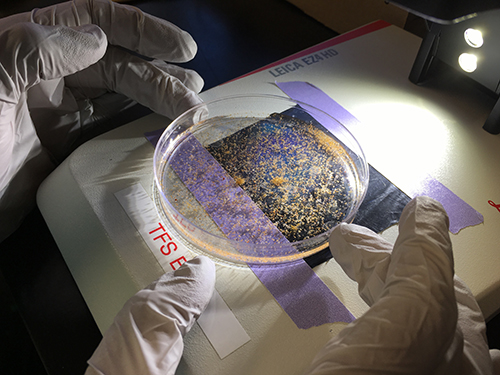 Petri dish with zooplankton. Photo by DJ Kast
Petri dish with zooplankton. Photo by DJ Kast
Dr. Byron Crump invited OSU colleague Dr. Kim Bernard to Toolik, Antarctic marine zooplankton expert, to look into the potential for collaboration on freshwater plankton experiments in the Arctic. To do this type of research, we went to various freshwater lakes sites such as Toolik Lake and the I-Series (I-1 through I-6 headwaters: 6 lake sites), and we took out a small boat to the middle of the lake and put a plankton net (ice-cream cone shaped net with a collecting cup at the bottom called a cod-end).
The net has a specific size mesh to specifically catch plankton. The ring on the front of the net is too small for fish to get caught in.
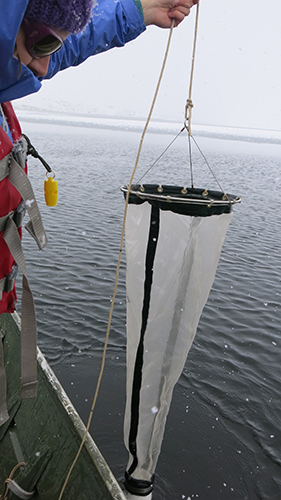 Plankton Net. Photo by DJ Kast
What are plankton?
Plankton Net. Photo by DJ Kast
What are plankton?
Plankton are microscopic organisms that live in both fresh and saltwater systems. The two main types of plankton are phytoplankton and zooplankton. Phytoplankton are like the plants of the freshwater systems and photosynthesize to provide the other lake organisms with oxygen and food. Zooplankton are next up in the food chain and are aptly named zooplankton because they are the animal plankton. Some are herbivorous and eat the phytoplankton, others are carnivorous and eat other zooplankton. Small fish eat the zooplankton to survive. Zooplankton are a crucial component of the lake food web.
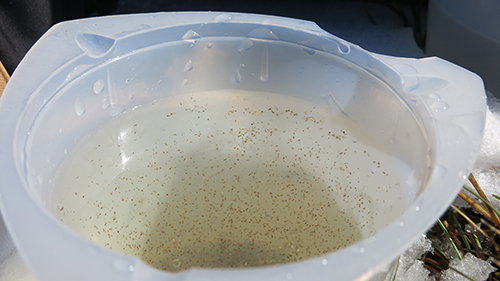 Plankton Closeup. Photo by DJ Kast
Main types of zooplankton
Plankton Closeup. Photo by DJ Kast
Main types of zooplankton
There are two main groups of zooplankton in the freshwater lakes. The two main groups are: copepods and cladocerans.
- In terms of the copepods, there are two types: Cyclops (One single eye!) and Diaptomus - small and red.
- In terms of the Cladocerans there are two main types which are: Daphnia, Bosmina.
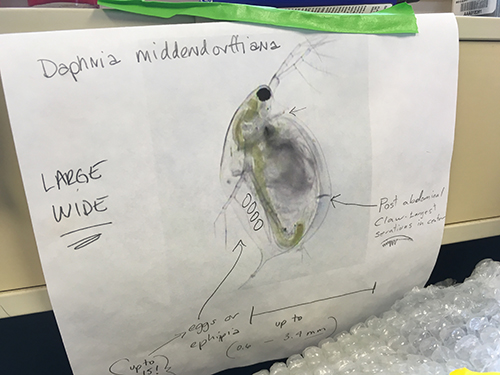 Daphia. Photo by DJ Kast
Daphia. Photo by DJ Kast
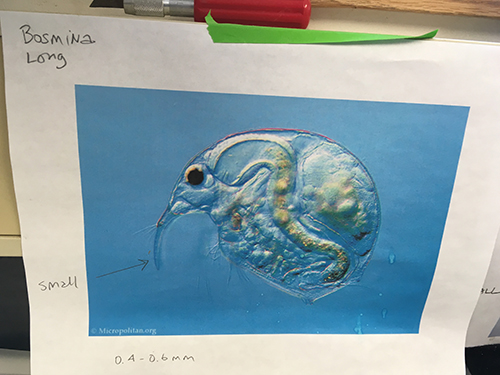 Bosmina. Photo by DJ Kast
Bosmina. Photo by DJ Kast
We have also seen fairy shrimp, ostracods, water mites and mosquito larva.
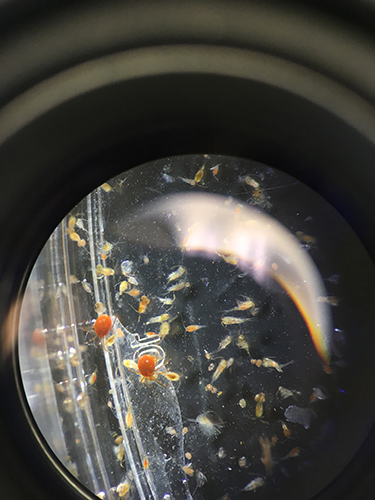 Water Mites. Photo by DJ Kast
Experimental Design
Water Mites. Photo by DJ Kast
Experimental Design
Dr. Crump and Dr. Bernard are looking at the role of copepods and cladocera providing surfaces for microbiomes of animal-associated bacteria within freshwater systems. The experiment was designed to see if it was possible to measure the rates of respiration by the bacteria inside and on top of the copepods and cladocerans. The experimental design included two treatments – one with zooplankton and antibiotics and one with zooplankton without antibiotics. The antibiotics were added to kill the microbiomes so they could measure the amount of respiration coming from the copepods. Both of the zooplankton (with or without antibiotics) were starved so that the microbes measured were only from the gut and outside of the copepods versus the microbes associated with their food.
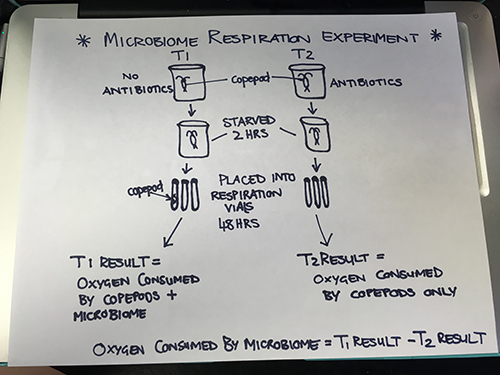 Experimental design. Photo by DJ Kast
Experimental design. Photo by DJ Kast
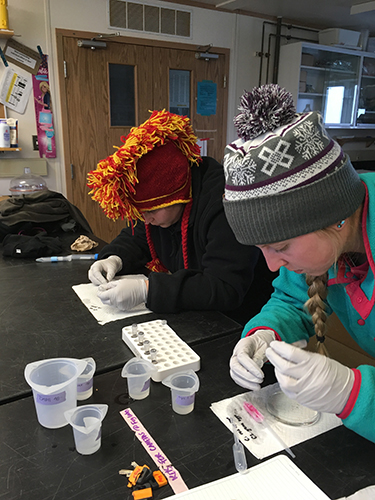 Johanne and I sifting through plankton. Photo by DJ Kast
Toolik Lake Zooplankton collecting
Johanne and I sifting through plankton. Photo by DJ Kast
Toolik Lake Zooplankton collecting
On Tuesday, we had a snow-storm but we had to collect those zooplankton. Dr Byron Crump, Dr. Kim Bernard, Johanne Albrigtsen, and myself got into "Slimy" the motorboat and headed out to "sea". Once we found a location that seems favorable, we used a dive buddy to figure out the exact depth of that location.
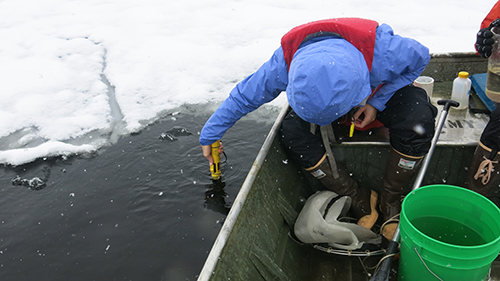 Dr. Kim Bernard checking out the depth in Toolik Lake with a dive buddy. Photo by DJ Kast
Dr. Kim Bernard checking out the depth in Toolik Lake with a dive buddy. Photo by DJ Kast
Once we have that depth, the zooplankton nets are sent to that depth, then are towed to collect zooplankton. and are finally pulled back up into the boat.
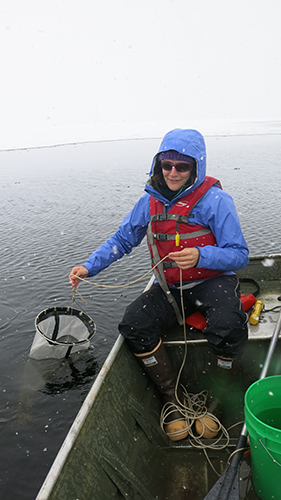 Dr. Kim Bernard collecting zooplankton in the snow. Photo by DJ Kast.
Dr. Kim Bernard collecting zooplankton in the snow. Photo by DJ Kast.
The cod-end then has a sample of zooplankton and water that can be placed into a separate container for storage.
I seriesThe day after the snowstorm we also went into the field to start the I-series water sample gathering.
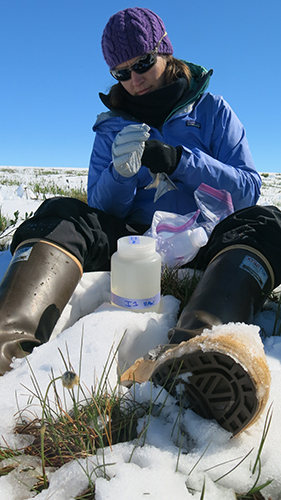 Dr. Kim Bernard with Zooplankton. Photo by DJ Kast
Dr. Kim Bernard with Zooplankton. Photo by DJ Kast
Dr. Kim Bernard joined the Lakes crew and nets were towed in the middle of each of the lakes.
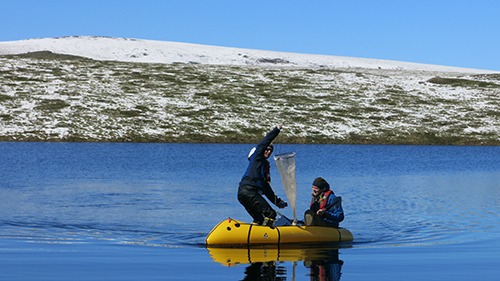 Sam and Brecia with the Zooplankton net in the middle of the Lake. Photo by DJ Kast
Sam and Brecia with the Zooplankton net in the middle of the Lake. Photo by DJ Kast
In the field, these raw samples were sieved and then the plankton was placed into filtered water.
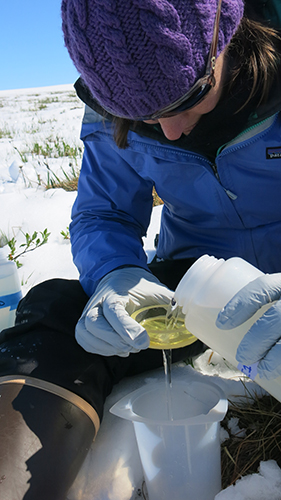 Kim sieves the copepods out of the Lake water sample. Photo by DJ Kast
Copepod Close-up
Kim sieves the copepods out of the Lake water sample. Photo by DJ Kast
Copepod Close-up
Dr. Kim Bernard loves working with the microscopes and spends hours behind the two lenses to see the zooplankton up close.
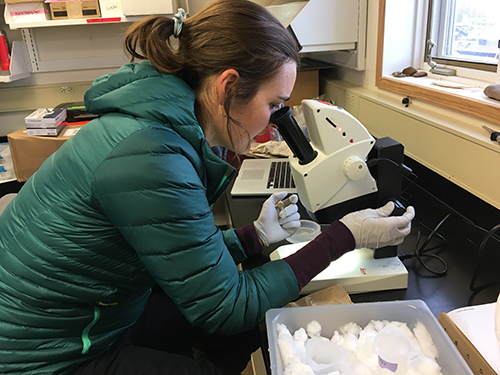 Dr. Kim Bernard at the microscope looking at her zooplankton. Photo by DJ Kast
Dr. Kim Bernard at the microscope looking at her zooplankton. Photo by DJ Kast
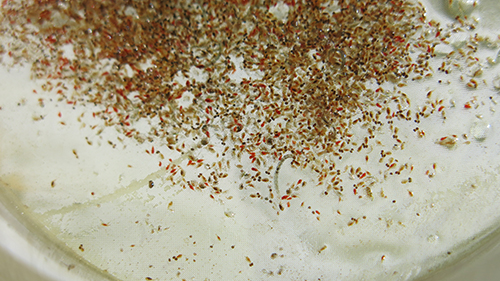 Zooplankton Closeup. Photo by DJ Kast.
YSP Flags
Zooplankton Closeup. Photo by DJ Kast.
YSP Flags
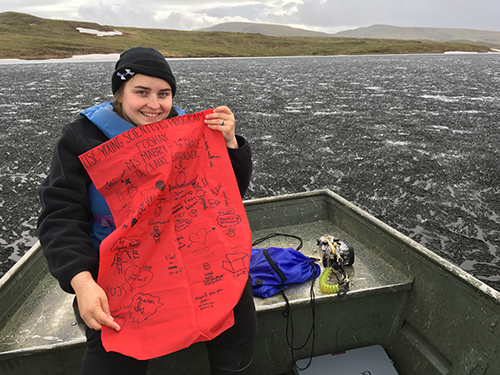 YSP Polar Flag from Ms. Mabry's classroom at Foshay Elementary and YSP TA Claire Chatinover. Photo by DJ Kast
YSP Polar Flag from Ms. Mabry's classroom at Foshay Elementary and YSP TA Claire Chatinover. Photo by DJ Kast

Comments